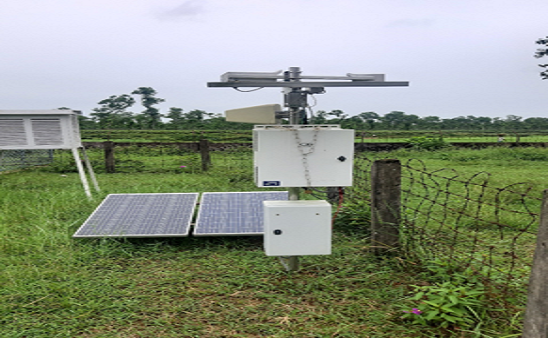Autonomous Weather Monitoring Stations

- Autonomous Weather Monitoring Stations (AWS)
They are automated versions of traditional weather stations that can measure, record, and transmit weather data without human intervention. This makes them ideal for remote or inaccessible locations, as well as for applications where continuous monitoring is required.
AWS typically consist of a weather-proof enclosure that houses the data logger, sensors, and telemetry equipment. The sensors measure a variety of weather parameters, including temperature, humidity, wind speed and direction, precipitation, solar radiation, and barometric pressure etc. The data logger records the sensor readings at regular intervals, and the telemetry equipment transmits the data to a remote server or network. AWS can be used for Weather Forecasting, Climate Monitoring, and Disaster Management.
- Weather forecasting
AWS data can be used to improve weather forecasts by providing more accurate and timely information about current and future weather conditions. This is because AWS data is collected 24/7, which provides a more complete picture of the weather than traditional stations that are only manned during certain hours. Additionally, AWS data can be stored for long periods of time, which allows for detailed analysis of weather patterns over time. This information can be used to improve the accuracy of weather models, which in turn can lead to more accurate weather forecasts.
For example, the National Oceanic and Atmospheric Administration (NOAA) uses AWS data to improve its weather forecasts. NOAA has a network of over 1,000 AWS in the United States, and this data is used to improve the accuracy of NOAA’s weather forecasts for the United States and the world.
- Climate monitoring
AWS data can also be used to track changes in climate over time. This is because AWS data can be stored for long periods of time, which allows for detailed analysis of weather patterns over time. This information can be used to identify trends in climate change, such as the increasing frequency and intensity of extreme weather events.
For example, the National Center for Atmospheric Research (NCAR) uses AWS data to track changes in climate over time. NCAR has a network of over 100 AWS in the United States, and this data is used to study the effects of climate change on the environment.
- Disaster management
AWS data can also be used to monitor weather conditions in areas that are prone to natural disasters. This information can be used to help authorities to issue warnings and to evacuate people from danger.
For example, the Federal Emergency Management Agency (FEMA) uses AWS data to monitor weather conditions in areas that are prone to hurricanes. FEMA has a network of over 100 AWS in the United States, and this data is used to help FEMA to issue warnings and to evacuate people from danger in the event of a hurricane.
AWS are a valuable tool for weather monitoring and forecasting. They offer a number of advantages over traditional weather stations, and they are becoming increasingly affordable. The cost of an AWS varies depending on the features and specifications of the system. However, they are generally more affordable than traditional weather stations, and they offer a number of advantages, including:
- Continuous monitoring
Traditional weather stations are typically manned during certain hours, which means that there are periods of time when no data is being collected. This can be a problem, especially if you need to track weather patterns over time. AWS, on the other hand, can collect data 24/7, which provides a more complete picture of the weather. This is especially important for areas that are prone to extreme weather events, such as hurricanes or tornadoes.
- Remote operation
AWS can be operated remotely, which means that you don’t need to have someone on site to collect data. This can save you money on labor costs, and it also makes it easier to monitor weather conditions in remote or inaccessible locations.
- Long-term data storage
AWS data can be stored for long periods of time, which allows for detailed analysis of weather patterns over time. This information can be used to improve weather forecasting models, track changes in climate, and study the effects of weather on the environment.
Overall, AWS offer a number of advantages over traditional weather stations, including continuous monitoring, remote operation, and long-term data storage. These advantages make AWS a valuable tool for weather monitoring and forecasting.
Here are some additional advantages of AWS:
Reliable: AWS are typically more reliable than traditional weather stations, as they are less likely to be affected by factors such as vandalism or power outages.
Scalable: AWS can be easily scaled to meet the needs of different applications. For example, you can add more sensors or increase the data storage capacity as your needs grow.
Cost-effective: AWS can be a cost-effective solution for weather monitoring, as they can save you money on labor costs and maintenance.
Overall, AWS are a valuable tool for weather monitoring and forecasting. They offer a number of advantages over traditional weather stations, and they are becoming increasingly affordable. If you are looking for a reliable, scalable, and cost-effective solution for weather monitoring, then an AWS is a good option to consider.






